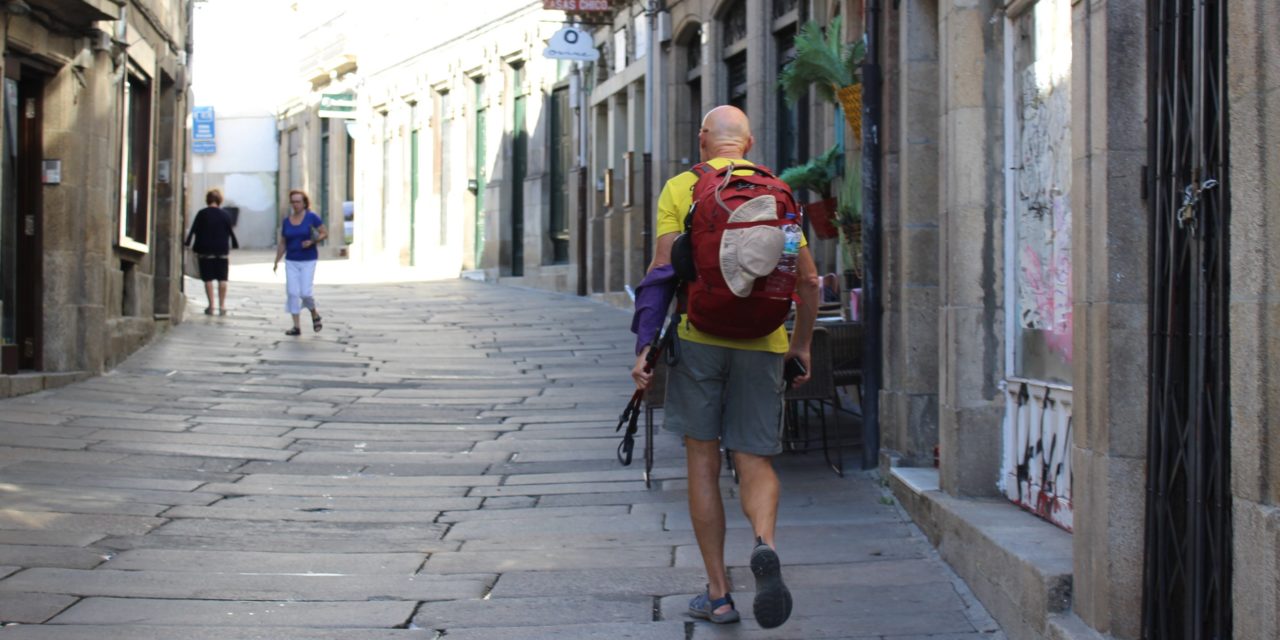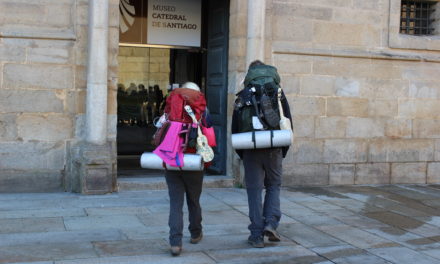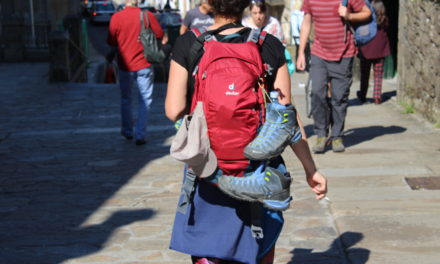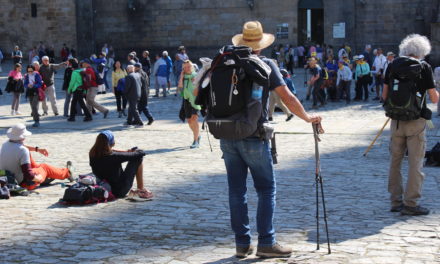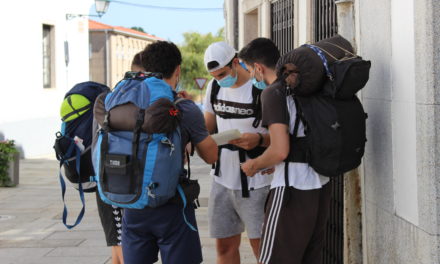He was born in Santiago 62 years ago. His first Camino was by bicycle, about ten or eleven years ago, and he traveled this way because he had inherited the bicycle of a Chilean pilgrim.
His son had met a pilgrim, a Chilean man who asked him where the bus stop was to go to the airport and also if he knew what he could do with his bicycle that he had put in a repository. His son offered to accompany him to the bus stop and told the Chilean that maybe he would have problems and he would not be allowed take his bike on board- like that, at the last minute. Then the bus arrived and when the pilgrim was getting on it, his son offered to take care of his bicycle, and to send it to him in Chile. Then the pilgrim said no, that he preferred to give it to him, gave him a key to the bike repository of the old Pilgrim’s office and told him to take the bike and keep it.
The Chilean pilgrim had traveled 5,000 with that bicycle that his son took home and, somehow, he ended up inheriting it. He fixed it up, gave it a name and, finally, went to do the Camino, just like its previous owner.
There was 2008 when he decided to do the French Way from Saint-Jean-Pie-de-Port, in the month of June. He loved it. There was no overcrowding and he was able to meet many people because, although he was on a bike, he travelled slowly – and as always – very calmly, breaking up his journey into short stages. He remembers that on that occasion he met many French and German people. He stayed in pilgrims’ shelters, an experience that he also enjoyed, not so much because it was cheap as for having that experience. In fact, the money he saved by sleeping in shelters was spent on eating well.
After that first experience he has traveled along many bicycle routes, most of the routes of the Camino de Santiago. After the French Way, he traveled the Camino del Interior in Portugal -from Viseu through Chaves and Verín- and the Vía de la Plata from Seville, a hard road because of the heat, now he usually travels this route in the spring. Then he repeated the French Way on several occasions, starting each from different points and he has now travelled most of the Ways to Santiago: the English Way, the Northern Way along the Coast (from Irún), the Primitive Way from Oviedo and the Portuguese Way, where he started from Vigo, descended and then it returned from Viana to Santiago. He has also toured some lesser known routes, such as San Andrés de Teixido.
Most of the ways he has travelled by bicycle but also on occasions he has gone on foot. He remembers walking from León to Salvador de Oviedo in the month of June- it was a spectacular experience, with lots of sun, and lots of light.
Three years ago, traveling the Portuguese Way, he discovered in a hostel the existence of the Camino de la Geira, a historical route between Braga and Santiago, still not signposted but full of history and crossing natural landscapes of great beauty. He was very interested in the idea and, finally, two years ago he decided to visit it.
The Camino de la Geira is for walking rather than cycling because very little of the route is asphalted. The first time he toured it was autumn, it started on October 12th. He loved the whole Portuguese stretch, from the start in Braga, where they visited the cathedral and started walking. They were guided by the website <www.debragaasantiago.com> created by the Codeseda association, always with the criterion that, when it was possible to choose, they used dirt roads.
He made the Camino with a group of 12 people and in different sections and moments. They went through it in brief stages, they wanted to enjoy the Camino, a difficult, adventure route, but very beautiful. The first section of the Camino was the Portuguese one that largely follows a Roman road and is well maintained and signposted, the signpost responds to the road but also to its nature as an itinerary to Santiago, as many yellow arrows have already been painted.
They went through it in four stages, instead of the three indicated by the existing guides. After Braga they stopped at Caldelas, a beautiful seaside resort; the second stage they walked to Geres and it seemed spectacular, as well as the youth hostel where they slept; the next stage was to Lobios, it is beautiful, it runs along the river, and in Lobios there are good hotels; The next stage they wanted to walk to Castro Laboreiro, but finally they had to stop at Meixoeira, a border town.
The Galician part is longer and they travelled along it on several weekends throughout that winter and spring, so they walked through it with rain, snow and sun. Everyone was delighted, it seemed spectacular. Apart from its natural beauty there are many ancient villages, several of them abandoned, all built of stone and very beautiful.
Compared with Portugal, yes, the Camino is more neglected in Galicia. The town councils should clean it, in fact Jaime believes that this Camino only lacks that: cleaning by hand and signposting. He says it because, really, the Way is always present, you see, there is a very clear path, a route, with remains. They are not the remains of Roman road as in the Portuguese section but are clearly of medieval origin. But he insists that you can see the historical route when walking, you have at all times the feeling and awareness that you are travelling along a route and all that is needed is cleaning and signposting, i.e. yellow arrows like those that have begun to be painted in Portugal by some associations. This is what is missing for this route: improving signposting in Portugal and signposting and cleaning in Galicia.
As an experienced cyclist, he believes that it is a hard route to go cycling on, but certainly on a mountain bike you could do it, as you would not have much weight. Walking is not so hard, especially if you do not try to travel long distances, something that in some cases is difficult because of the infrastructure, but there are always places to sleep to be found. The Camino, yes it is beautiful. There is hardly any asphalt but it can be travelled without too much difficulty because there are no great heights.
The Camino de la Geira offers a spectacular nature, a route that allows you to reach Santiago in 10 or 11 stages and for those that wish it, it will allow you to experience of solitude, to experience what it is to be a pilgrim, to get away for a little from the world and from everyday life. But whoever wants to travel in a group, as they did, will also have a very satisfactory experience.
Another advantage of this route is the point at which it enters Santiago, which does not coincide with other roads, only from the Sar with the Vía de la Plata, and therefore it allows you to enter Santiago without any crowding whatsoever. And he points out: they had no coverage problems, so using the Internet and Wikiloc is possible.

